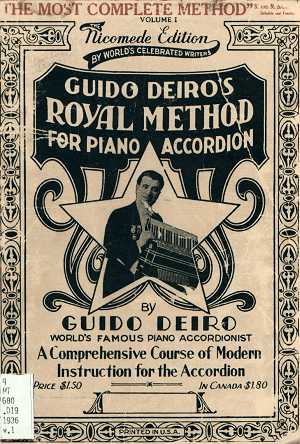 for Piano Accordion, Vol. 1 Nicomede Music Company Edition |
2. Guido Deiro [biography]
3. Notation
4. Sharps, Flats and Naturals
5. Playing Position
6. The Piano Keyboard
7. The Chromatic Keyboard
8. How To Play
9. Right Hand Studies
10. Easy Exercises
11. Quarter Notes
12. Various Studies
13. Unnamed Melodies
14. The Basses
15. Playing the Basses
16. Standard Bass Keyboard Chart
17. Special Bass Keyboard Chart
18. Accordionette, Waltz
20. Studies
21. The Young Accordionist, March
22. Fundamental Basses
23. Fundamental and Harmony Basses
24. Little Accordion Player, Waltz
25. The Inverted Bass
26 Studies
27. Exercises on Counter Basses
28. Torpedo March
30. Sixteenth Notes
31. Diatonic Bass Scale
32. Over The Waves
33. Two Note Studies
34. Sharps and Flats
35. Cut Time
36. Arpeggio Study
37. Veno Fox Trot
38. scale in F
39. King Boy, Fox Trot
40. Scale of A Minor
41. Six Eight Time
42. Duet Study
43. Scale of D in Unison
44. Triplets
45. Scale of E Minor in Unison
46. Jewel Waltz
48. Scale of A
49. Embellishments
50. Scale of D Minor
51. Whiskey Polka
52. Syncopation
53. Chromatic Scale
54. Pep Polka
56. Beautiful Girl, Waltz
57. The Bass Clef
58. Bass Studies
59. Waltz from Il Trovatore
60. Scale of Bb
61. Melody Duet
62. Scale of Eb
63. Agility and Strength Study
64. Scale of E
65. Radio Waltz
66. Etude in D Minor
67. Syncopation in D
68. Scale of Ab
69. Orchestral Chords in Ab
70. Dance Orchestra Chord Study
71. Exercises
72. My Dear, Waltz
75. Dolce Amore, Mazurka
76. Exercises
77. Accordion Amusement
78. Gibson Beauty, March
80. Accordion Blues, Fox Trot
82. Naughty Joe, Fox Trot
83. Playing from A Piano Part
84. Jack and Jill, Fox Trot
86. Minneapolis March
88. Sharpshooters March
90. Accordion Operatic
92. Il Trovatore
94. Imitations
Guido Deiro's Royal Method for the Piano Accordion (1936) taught the beginning student:
Gradually the difficulty of the subsequent exercises and songs were increased until the student could play fairly advanced arrangements of familiar opera melodies.rudiments of music, ie. the staff and clef, names of notes, durations of notes, sharps, flats and naturals, keys and their signatures, dots and slurs, dynamic expressions, etc.
how to hold the accordion properly
names of right-hand keys and left-hand buttons and a explanation of The Switch which allowed octave doubling.
studies, exercises and songs appropriate for the student's ability
The following compositions in volume one were composed by Guido Deiro:
Accordionette Waltz
The Young Accordionist
Little Accordion Player Waltz
Torpedo March
Jewel Waltz
Beautiful Girl Waltz
Radio Waltz
The following compositions were composed by Joseph W. Nicomede:
Whiskey Polka
Pep Polka
My Dear Waltz
Dolce Amore Mazurka
Gibson Beauty March
Accordion Blues Fox Trot
Jack and Jill Fox Trot
The following compositions were composed by Nicomede-Deiro:
Veno Fox Trot
King Boy Fox Trot
The Peasant Quadrille
Minneapolis March
The following compositions were written by other composers:
Unnamed composer: Over the Waves
G. Verdi: Waltz from Il Trovatore
Stephen Foster: Old Folks At Home
Unnamed composer: Naughty Joe
Unnamed composer: Sharpshooters March
G. Verdi: Accordion Operatic
G. Verdi: Il Trovatore
In his method, Deiro notated the accordion left-hand staff in treble clef as was the practice of the day, but had the foresight to introduce bass clef notation later on in the book as the student progressed. He also showed the student how to play from a piano part.
Especially interesting is the last page -- Imitations and Special Effects -- which show the student how to produce the following:
Imitations:
The Laugh
The Mandolin
The Violin
Player Piano
The Organ
Special Effects:
The Bellows ShakeClick Here (174 KB) to see an advertisement for "Deiro's Royal Accordion Method."
The Vibrato
The Glissando
Rolling Chords
| |